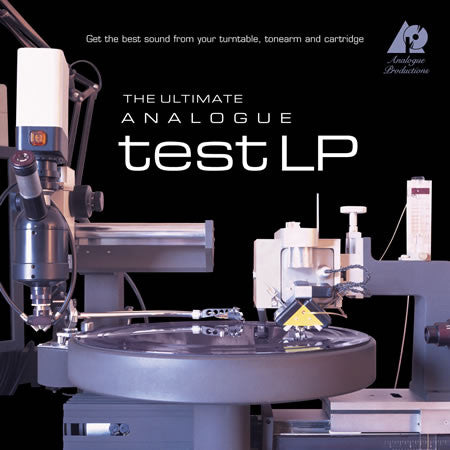Note: Turntable setup tools are final sale only, and are not covered by our return policy.
Analogue Productions consulted many experts in the field to create a 200-gram test record that's never been made before. It’s designed to provide the basic test signals necessary to calibrate a turntable or cutting lathe. We suggest the Fozgometer in conjunction with this LP.
Side 1
This 1 kHz reference tone will allow you to establish a “base level” for all measurements. Track 1: 1Khz reference tone 7cm/s Mono, in phase (Lateral) - Basic reference for all measurements. Adjust preamp channel balance for equal output. Also used to check the offset angle of the photo cartridge; L&R signals should be exactly in phase.
Azimuth Adjustment
Track 2: 1kHz reference level - Left channel only. Measure Right channel output. Track 3: 1kHz reference level - Right channel only. Measure Left channel output. The object is to sit the stylus exactly perpendicular in the groove. Twist cartridge about its radial axis until the measurements from Track 2 and Track 3 are equal or very close to equal for both channels.
High Frequency Adjustment
Tracks 4, 5 and 6 are used to calibrate the RIAA high frequency equalizer of a phono preamp.- Track 4 1 kHz tone at -20 below reference level, Lateral
- Reference for High Frequency test.
- Track 5 10 kHz reference tone at -20dbu, Lateral
- Adjust the high frequency until the output level equals Track 4.
- Track 6 1 kHz to 20 kHz sweep at -20dbu, Mono Lateral
- The AC millivoltmeter reading should stay constant across all frequencies. There many factors which can affect frequency response, including cable capacitance, cartridge loading, tracking force and worn parts. Sometimes by making small compromises in the 10 kHz adjustment, a better overall frequency response can be achieved.
Low Frequency Adjustment
- Tracks 7 & 8 are used to calibrate the RIAA low frequency equalizer of a phono preamp.
- Track 7 1 kHz to 20 Hz sweep at 0 VU Lateral
- Play Track 7 and measure the output with your AC millivolt meter.
- Ideally, the output will be flat across all frequencies. When viewed on an oscilloscope, the amplitude would remain constant during the frequency downsweep.
- Track 8 100 Hz reference tone at 0 vu Lateral
- Adjust LF Eq to reference (which is your reading from Track 1).
- Track 9 VTA adjust
- This is an IEC intermodulation distortion (IMD) test signal; 60Hz & 4kHz 4:1 ratio.
- Using an IMD tester, adjust VTA by raising or lowering the tonearm for minimum distortion.
- Track 10 Standard Wow & Flutter test signal; 3150Hz
- The Wow & Flutter meter will give dynamic speed variations as a percentage deviation from nominal.
- Also, the frequency counter should read exactly 3150 Hz for nominal speed. You can use the Hz function on your multi-meter to verify speed here as well. You can also use to find the measurements at 45RPM. The correct reading at 45RPM would be 4253 Hz (45/33.33) x 3150.
Side 2
- Track 1 Anti-skating test; 315Hz amplitude sweep to +12dbu (Lateral)
- Signal should remain clean in both channels up to the highest level, both audibly and as viewed on an oscilloscope. In case of distortion, increase anti-skating force or decrease anti-skate until breakup occurs equally in both channels. The left channel information is inscribed on the inner groove wall, the right channel information, on the outer groove wall. Because of the offset angle of a pivoted tonearm, a constantly varying vector force biases the arm towards the center of the record causing the stylus to lose contact with the outer (i.e. right channel) groove wall. Both linear and modulated groove velocity, tracking force, stylus profile, and vinyl composition are contributing factors. The anti skating force attempts to ameliorate this by applying an opposing similar force.
- It is also accepted that the overall force vector increases as the tonearm approaches closer to the spindle or end of the record.
- Track 2 Pink noise lateral
- Track 3 Pink noise vertical
- Used for cartridge “demagnetizing”
- You can also use this track to loosen up the cantilever’s suspension to help break in a new cartridge.
- Track 4 1kHz @ reference level, vertical
- This out-of-phase signal should cancel to nothing when summed to mono.
- Any signals still present are distortion artifacts, lack of channel balance, or timing (phase) anomalies. This test can be a second confirmation of anti-skate adjustment.
- Track 5 1kHz to 10Hz sweep @ -20 below reference level, vertical
- Resonance anomalies in the tonearm / cartridge interface will show up as amplitude peaks and dips as the frequency sweeps down.
- Once again, by listening in ‘Mono’ it is easier to hear the distortion artifacts.
- During playback of this track, nothing should be transmitted from the turntable to the speakers. Replay the track and gently tap on the rack or base that the turntable is resting on. There should be little or no thump transferred to the speakers. This track will help you experiment with turntable isolation methods and products to be able to get the most out of your playback system.







